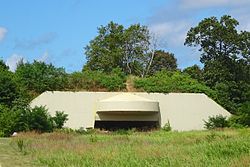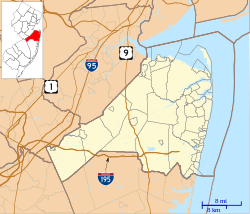Highlands Air Force Station
| Highlands Air Force Station USAF transmitter call sign: "Jitney" |
|
|---|---|
| Part of Air Defense Command |
|
| Coordinates | 40°23′29″N 073°59′38″W / 40.39139°N 73.99389°W |
| Type | General Surveillance Radar Station |
| Code | L-12: 1948 Lashup Radar Network P-9: 1949 ADC permanent network Z-9: 1963 July 31 NORAD network |
| Site information | |
| Controlled by |
|
| Site history | |
| In use | 1948-1966 |
| Garrison information | |
| Past commanders |
Major Weston F. Griffith (1955-1961) |
| Garrison |
|
|
Navesink Military Reservation Historic District
|
|

Battery Lewis - Casemate front
|
|
| Location | Grand Tour Road and Portland Road, Middletown Township, New Jersey |
|---|---|
| Coordinates | 40°23′26″N 73°59′20″W / 40.39056°N 73.98889°WCoordinates: 40°23′26″N 73°59′20″W / 40.39056°N 73.98889°W |
| NRHP Reference # | 15000011 |
| NJRHP # | 5389 |
| Significant dates | |
| Added to NRHP | October 13, 2015 |
| Designated NJRHP | August 28, 2015 |
|
|
|
|
|
Highlands Air Force Station was a military installation in Middletown Township near the borough of Highlands, New Jersey. The station provided ground-controlled interception radar coverage as part of the Lashup Radar Network and the Semi-Automatic Ground Environment network, as well as providing radar coverage for the Highlands Army Air Defense Site. The site's 240 acres (97 ha) is now the Rocky Point section in Hartshorne Woods Park of the Monmouth County Parks System.
The Navesink Military Reservation (also called the Highlands Military Reservation) was added as a historic district to the National Register of Historic Places on October 13, 2015.
The Navesink Highlands had a sea navigation beacon in 1746, and the first Navesink Twin Lights lighthouse was built in 1828. The current Navesink Twin Lights lighthouse was built in 1862. The Navesink Highlands were used for antebellum flag signaling experiments that communicated with Fort Tompkins on Staten Island in 1859. In 1899 Guglielmo Marconi built a radio station on the hill next to the north tower of the Navesink Twin Lights to report on the America's Cup races off of Sandy Hook.
In 1917 during World War I, four 12-inch coast defense mortars were placed on the Navesink Highlands for seacoast defense, transferred from the mortar batteries at Fort Hancock, New Jersey on Sandy Hook. These were called Battery Hartshorne. The battery was named for Richard Hartshorne, a settler who acquired the land in the 1670s. This battery was disarmed in 1920. By 1933, Harold A. Zahl's radio range experiments had begun from the Twin Lights lighthouse, and an August 1935 US Army Signal Corps radar test at the lighthouse allowed a searchlight beam to track an aircraft. An SCR-268 radar assembled in August 1938 was demonstrated at the Twin Lights lighthouse in 1939. In 1942-44 the Navesink (or Highlands) Military Reservation was built, which included Battery Isaac N. Lewis (also called Battery 116), a casemated coastal defense battery of two 16"/50 caliber Mark 2 guns, along with Battery 219, a coastal defense battery of two 6-inch M1903 guns on the hill to the south of the Twin Lights Lighthouse. The batteries were garrisoned by the United States Army Coast Artillery Corps as part of the Harbor Defenses of New York. Battery Lewis was one of the primary batteries guarding Greater New York in World War II, along with another 16-inch battery at Fort Tilden in Queens and two 12-inch long-range batteries at Fort Hancock on Sandy Hook. These rendered all previous heavy guns in the area obsolete, and these were gradually scrapped during the war. After World War II it was determined that gun defenses were obsolete, and the guns at Navesink were scrapped in 1948.
...
Wikipedia



